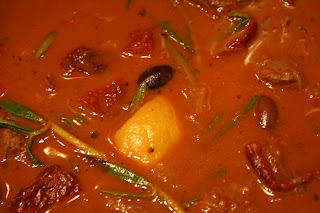
Ingredients
olive oil
500 g of Swiss chard
1 teaspoon of paprika
1 teaspoon of cumin
1 teaspoon of mixed spice
½ teaspoon of chilli powder
1 teaspoon of salt
½ teaspoon of black pepper
500 g tomatoes
juice of 1 lemon
1 tin of chickpeas
Method
- Remove and discard the ends of the chard stalks. Separate the stalks from the leaves, and slice the stalks and the leaves thinly. Wash the stalks and the leaves separately. Chop the tomatoes into large chunks (4 pieces if using medium-sized tomatoes, 6 or 8 pieces if using larger ones).
- In a large saucepan pan, add the chard stalks to the olive oil and fry gently until they have softened. Once the stalks are reasonably soft, add the spices, together with the salt and pepper, and fry for 30 seconds.
- Add the tomatoes, and stir to mix, then place the chard leaves on top, then the cooked chickpeas, pour the lemon juice over it and cover. (The flavours and textures of the different ingredients should still be clearly distinguishable at the end, so don’t stir the ingredients at this stage, and don’t be tempted to make tomato sauce!) The dish is ready to serve once the chard leaves have softened (about 5 minutes or so).




